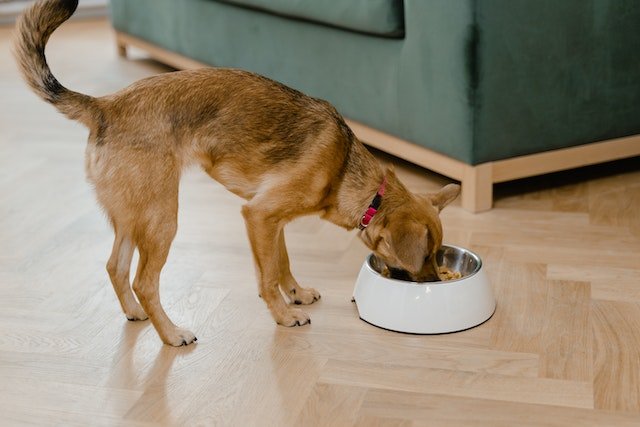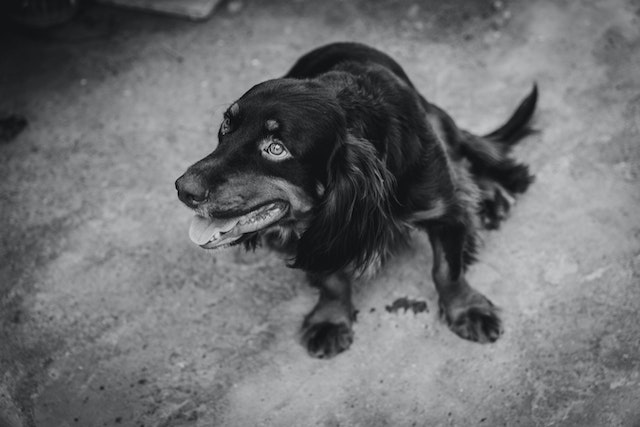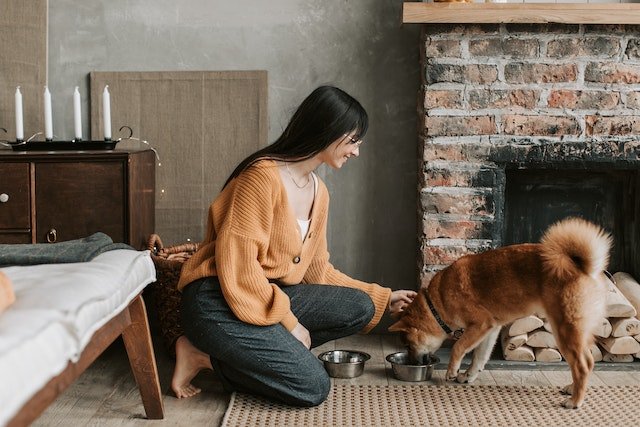We're an affiliate
We hope you love the products we recommend! Just so you know, we may collect a share of sales or other compensation from the links on this page at no additional cost to you. Thank you if you use our links, we really appreciate it!
As a responsible dog owner, you should know how long you should wait to take your dog out after eating, and there’s a good reason for it.
In this post, we’ve highlighted the digestion process in dogs and explained why you should not take your dog out with a full stomach.
Read on to discover the risks associated with walking your dog immediately after eating and the safe alternative activities you can engage in during the waiting period.
A Brief Overview of The Digestion Process in Dogs
In order to understand the best waiting time for dogs after meals, we need to appreciate canine digestion and how long it takes.
The digestion process in dogs is a lot simpler than that of humans. This means that our furry friends have a shorter time to process food, absorb nutrients, and eliminate waste.
The canine digestive process starts in the mouth during chewing. The large chunks of food are broken down and mixed with the enzyme α -amylase found in canine saliva.

The enzyme helps to chemically break down the food before swallowing and it helps in digesting starch.
The small lumps of food are then pushed through the esophagus into the stomach where further digestion occurs.
The cell lining on the dog’s stomach secretes several substances including weak hydrochloric acid which helps digest proteins.
The acidic semi-liquid food in the stomach, known as chyme, is then pushed downwards into the small intestines for further digestion and absorption of several nutrients.
Chyme is mixed with pancreatic juice in the first phase of the small intestines which helps to break down carbs and fats.
The nutrients and minerals from the food are then absorbed into the walls of the small intestines and transported into the bloodstream.
The remaining material is then pushed downwards to the large intestines where water absorption takes place before elimination of the waste.
Factors Affecting Digestion Time in Dogs
1. Size and breed of the dog
The larger the dog, the longer it will take for them to break down food and absorb the nutrients.
Small dog breeds have been estimated to take around 4 hours for ingested food to go through the digestive tract, while large breed dogs take anywhere between 8 to 9 hours.
Large breed dogs like Doberman Pinschers have also been found to produce looser stool compared to small breeds, and this shows the contrast in the digestion process between the dog’s breed and size.
2. Underlying health condition
The health condition and medication history of your dog can affect their digestion time. Healthy dogs will take an average of 8 to 9 hours to fully digest their food.
Dogs on specific medication may have quicker or slower digestion processes depending on the side effects of the drugs.
If your dog is recovering from surgery or coming from sedatives, they may take a relatively shorter time to fully digest food. You may also notice a difference in their stool consistency and pooping frequency.
Your dog’s digestion process should return to normal after completing medication and when they fully recover from specific conditions.
3. Age of the dog
Elderly dogs have a much slower digestion process compared to young adults and puppies.
As dogs advance in years, they are prone to suffer digestive issues and constipation due to the reduced effectiveness of the digestive system.
A senior dog is also likely to develop intolerance to certain foods and their stomach is prone to get more sensitive.
You should therefore watch your senior dog’s diet and be sure to provide them with all-natural dog-specific foods to support their gut health.
4. The dog’s diet
The type and nature of food your dog eats have a massive effect on their digestion process and time. Fiber-rich diets can pass through the dog’s gut much quicker than the other types of foods.
Dogs who rely on wet foods have a relatively shorter digestion time than those who eat dry kibble most of the time.
Wet dog food requires less time (4 to 6 hours) to pass through the digestive tract than dry kibble (8 to 10 hours) due to much higher moisture content.
Wet food is also low in carbohydrates which normally take a lot of time to break down and absorb.
Foods with high carbohydrate content are not good for dogs because they increase the chances of adding unhealthy weight.
If your dog is producing inconsistent stool and gas, and showing signs of gastric torsion, then it is more likely that their system is intolerant to specific foods.
How Long Should I Wait to Take My Dog Out After Eating
Most vets recommend waiting at least 2 hours after feeding your dog a large meal before taking them out for walks or exercise.
There are some exceptions to this rule and they all have to do with the amount of food your dog ingested.
For small snacks, you can wait at least 30 minutes before taking your dog out, and extend the wait for 1 hour if your dog ate a small meal.
Taking your dog out for walks or physical activities with a full stomach increases the risk of bloating, torsion, or twisting their gut (GDV).
Risks Of Immediate Physical Activity for Dogs After Eating
Taking your furry friend out with a full stomach is risky for their health and well-being. The following are some of the potential problems associated with immediate activity after eating:
1. Gastric Dilatation-Volvulus
Walking your dog with a full stomach can cause bloating also known as gastric dilatation-volvulus (GDV) in severe cases.
Bloating occurs in dogs when their stomach gets filled with air and twists itself.
GDV is a life-threatening condition in dogs because, as the fluid fills up in the stomach, there’s a build-up of pressure which stops blood from the abdomen area from flowing back to the heart.
This acute condition causes a large pool of blood to concentrate on the back end of the affected dog and this reduces the volume of working blood in the dog’s body.
The other shocking thing that may happen to dogs in this condition is rather unfortunate and painful. As the stomach twists, it drags the pancreas and the spleen together, and this action cuts off the blood flow.
This condition starves the pancreas of oxygen and it ends up producing some very toxic hormones which may have severe effects on the dog, especially on the cardiovascular system.
2. Discomfort and indigestion
Exposing your dog to intensive physical activities immediately after eating causes discomfort and may lead to indigestion.

3. Vomiting
When dogs engage in body movements shortly after eating, they may risk regurgitating swallowed food or vomiting.
This condition is prone to dogs who tend to eat their meals quickly or those who have underlying gastrointestinal conditions.
What You Can Do During Waiting Time
When your dog finishes eating their main meal, you may be wondering what can you do with them in the meantime.
There are plenty of activities you can engage in with your dog during this resting period without necessarily exposing them to physical intensive exercises.
1. Mental stimulating exercises
Working out your dog’s brain is an excellent activity you can engage in during this waiting period. Provide a few puzzle toys or treat-dispensing toys to play with as you watch how they solve the puzzle.
Brain-teasing exercises are good for dogs because they strengthen their brainpower and improve their problem-solving skills without putting strain on their digestive tract.
They also provide a form of self-entertainment which is beneficial in reducing stress and anxiety in dogs.
2. Practice obedience training
Waiting for the food to settle in your dog’s digestive tract can provide a good opportunity to practice obedience training.
Be sure that your dog doesn’t put any strain on their digestive system when practicing the taught commands.
You can practice some commands such as ‘sit and stay’, ‘come’, or ‘get off’.
How to Walk Your Dog After Meals
After waiting for about 2 hours after your dog had a large meal, you may now consider taking them out for a walk.
Walking your dog is beneficial in improving their physical health, and it also helps to regulate the digestive system when the food has already settled.
So, what are the best practices for taking your dog out for walks after meals? Here’s a typical routine that you can consider:
1. Establish a clear routine
Dogs work best when they know what’s expected of them and at what time. This calls for responsible pet parents to establish a clear routine for their furry friend and stick to it as much as possible.
Set aside regular feeding time for your dog and allow them enough time to rest before slotting in a walking plan.
Having a routine helps your dog in developing responsible behavior and it keeps them away from getting distressed or becoming anxious due to unpredictable events.
2. Start slowly and increase the pace
After allowing your dog enough time to rest for smooth digestion, you should resume activity by starting with less intensive exercises.
A good way is to leash your dog and take them for a brief walk in your yard before proceeding to other activities such as running, fetching, or jumping.
Starting slowly will allow your dog’s body to adjust to the new energy requirements without straining their digestive process.
You can gradually increase the activity levels by observing your dog’s willingness to play and make sure not to go overboard.

Signs Of Digestive Discomfort in Dogs
Digestion problem in dogs, also known as upset stomach, is an acute condition resulting from poor digestion or complete indigestion.
In some isolated cases, digestive problems in dogs can arise because the dog is developing intolerance to specific foods or ingested toxins.
Sometimes it is also caused by more severe factors such as bacterial or viral infections, or due to an underlying health condition.
Some of the most common signs of digestive problems in dogs are:
- Diarrhea
- Constipation
- Loss of appetite
- Vomiting
- Lethargy
- Abdominal pain (colic)
- Bloating
- Straining to poop
- Shock
- Dehydration
- Blood in stool
- Fever
If your dog is showing any of the signs of digestive problems, you should inspect their diet for anything unusual.
Sometimes dogs can overreact to new foods or become completely intolerant when you drastically change their diet.
If you have to change your dog’s diet, it’s always a good idea to do so progressively while monitoring allergies, and signs of discomfort.
For severe symptoms, you should call your vet immediately for medical attention.
Your vet will do a physical examination and blood work to determine the problem affecting your furry friend to rule out any medical condition.
Frequently Asked Questions (FAQs)
1. Can I walk my dog immediately after a small snack?
No! You should wait for at least 30 minutes before taking your dog out after eating a small snack.
Allowing enough time for your dog to break down the snack and settle it in their digestive system is crucial in preventing digestive discomfort.
2. Should I walk my dog before or after he eats?
Both scenarios are correct depending on how you walk the dog and their preference. If you’re walking your dog before a meal, make sure to consider their energy level and limit the distance.
If you prefer walking the dog after a meal, you should allow at least 2 hours after eating before taking them out.
3. Should I feed or walk my dog first in the morning?
It’s correct to either feed or walk your dog in the morning when they wake up. But you need to allow your dog at least 2 hours before walking them after meals.
Taking your dog out with a full stomach is risky and may potentially lead to bloating or digestive discomfort.
Conclusion
To recap, you should allow your dog at least 2 hours to rest after eating a large main meal before taking them out for a walk.
With small snacks and small-portioned meals, you can limit the waiting time to around 30 minutes to 1 hour.
Walking a dog with a full stomach may potentially expose them to gastric dilatation-volvulus which is an acute life-threatening condition.
It helps to understand your dog’s individual needs and work out a feeding and exercise routine to keep them healthy.
Laura is the founder of Furs'n'Paws. She is a also a pet writer and expert with more than 20 years of experience of working with dogs and cats. She developed a very strong love for animals at a young age. Her passion led her to establish a thriving pet sitting and dog walking business in Dubai. As an expert in pet training, behavior, and nutrition, Laura is committed to helping pet owners and pet lovers by offering high-quality information on a wide range of topics.



No responses yet